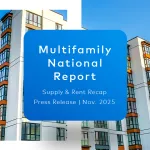Rent Moderation Season Dawns in August
Rent growth remained in the double digits in August, but the average asking rent marked the first month-over-month decline since June 2020.
Report highlights:
- Rent growth moderated in the final month of the summer, still up 10.9% on a year-over-year basis, to $1,718, but marking the first month-over-month decline since June 2020.
- With population growth decreasing, the main demand drivers are in-migration and household formation—occupancy remained at 96% for the fifth straight month in July.
- Renter-by-Necessity units continued to lead rent growth—up 0.2% in August—while Lifestyle rents posted a 0.2% contraction.
- Rent growth in the SFR sector fell in the single digits, up just 9.5%, down $2 to $2,090 in August; occupancy declined by 1% in July.
Rent Growth Posts Weakest Performance Since June 2020, Still Up 6.6% Year-to-Date
The national multifamily market ended its long run of unprecedented growth in August, when the average asking rent declined $1 to $1,718. Even so, the annual rent growth was still in the double digits, up 10.9%, while year-to-date growth posted a solid 6.6%, higher than any year prior to 2021. The strongest gains were registered in the Sun Belt—Orlando (16.9%), Miami (16.7%) and Nashville (14.8%), but these rates are 7 to 8 percentage points over the last two months, which is also a sign that affordability is intensifying.
Behind the softening is seasonality paired with slowing migration and the cooling economy. The impact is greater at this point because it succeeds unprecedented increases. On a first glance, this moderation in the housing market aids demand, but looking closer, rent declines were concentrated in the upscale Lifestyle properties, not in the Renter-by-Necessity segment.
Occupancy Marks Fifth Consecutive Month Above 96%; RBN Rents Remain in the Lead
The occupancy rate remained at 96% for the fifth month in July, with large variations among metros: the largest increases were registered in San Jose (1.5%), Chicago and San Francisco (each 0.8%) and New York (0.6%), and the largest contractions in Las Vegas (-1.8%), Phoenix (-1.4%) and Sacramento (-1.0%).
On a monthly basis, national asking rents contracted 0.1%, with RBN rents up 0.2% and Lifestyle rents down 0.2% in August. Asking rents increased in just 10 of Yardi Matrix’s top 30 markets in August, led by Philadelphia, San Francisco and Nashville (0.5% each), followed by New York and Miami (0.3% each). The largest decreases in asking rents were in Raleigh (-1.3%), Seattle (-1.1%) and the Inland Empire and Las Vegas (each -0.8%). Rent growth skewed negative due to contractions in the Lifestyle segment, present in 21 of Yardi Matrix’s top 30 metros.
Migration and Household Formation Drive Demand
Immigration dropped to 247,000 in 2021 from more than 1 million in 2016, according to the U.S. Census Bureau, and the pandemic created new migration trends—from high-cost states with large urban centers such as California, New York and Illinois—to state in the Sun Belt and Southwest. This was possible as some remote workers are no longer tied to offices and people search for lees expensive housing.
Interestingly, population decline occurred in most urban areas, even in fast-growing states. As shown by a Harvard Joint Center for Housing Studies report, of the 68 counties in the U.S. with at least 1 million people, 58 (85%) had net outflows in 2021, while 80% of counties in the outlying parts of these large metro areas had net inflows.
SFR Sector Mirrors Multifamily Industry, Rent Growth Moderates
The asking rent for the single-family sector rose 9.5% year-over-year, to $2,090, which translate into a 170-basis-point drop from July ($2). Of the top 35 markets tracked by Yardi Matrix, in 17 rents rose by 10% or more on an annual basis as of August. The highest increases were recorded in Washington, D.C. (40.1%) and Orlando (39.6%).
Occupancy rates also posted minor declines—the national rate was down by 1% on a year-over-year basis through July—increasing in only nine of the top 35 Yardi Matrix metros. Despite the moderation in rent growth and the occupancy deceleration, higher financing costs and fewer home sales are likely to sustain demand for SFRs.
Read the full Matrix Multifamily National Report-August 2022






![August 2022] Multifamily Market Report](https://www.yardimatrix.com/blog/wp-content/uploads/sites/39/2022/09/August-MF-iStock-1384896166.jpg?w=990&h=556&crop=1)




Add Comment